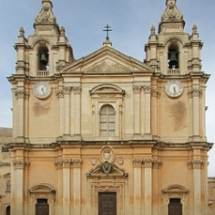Baroque Architecture
Array
Want create site? Find Free WordPress Themes and plugins.
In the early 17th century, the new style of Baroque which started as a Counter-Reformation design adopted by theRoman Catholic Church in Italy, spread through the Roman Catholic countries of Europe. This extravagant architectural technique reacted against the conservative rigidity of Renaissance design and was often used to express the triumph of the Catholic Church and the power of the state. It was characterized by the use of different shapes and the play of light and shadow in order to create more dramatic effects on the buildings’ facades.
On their arrival in Malta, the Knights were still using the medieval style which had served them in Rhodes, and in fact their earliest buildings in Birgu and Valletta included features of this outdated technique combined with Ġlormu Cassar’s simple Mannerist design that suited the military character of Valletta’s early buildings. Buildings that were constructed during the early period of the Order’s rule tended to be strict and restrained in decorative features. It was the resident architect Francesco Buonamici who introduced Baroque to Malta in 1635, when he designed the Jesuit Church.
Wishing to update their city to the standard of the finest capitals of Europe, the Knights brought a new elegance to the streets of Valletta with the construction of new churches, remodeling the facades of the auberges and public buildings, and dressing the fortification gates with Baroque decoration. The interior of St John’s Co-Cathedral was richly embellished with gilt wall carvings which lit up the interior. The style culminated in 1741 with the rebuilding of the Auberge de Castille, now the most monumental Baroque structure in Malta. This imposing square building designed by Andrea Belli features a wide flight of stairs leading to the main door, topped by a grand triumphal sculptural display of military symbols and flanked by richly-framed windows.
At the same time, the Catholic Church competed with the Knights to create Baroque landmarks. In the late 17th century, a new drive began to construct grander churches, topped by fat domes and belfries, to stand proud over the townhouses. The most outstanding of these churches was designed by Lorenzo Gafà; one of the most influential architects in the development of Baroque in Malta.
Gafà had no formal architectural training but he was lucky to serve as an assistant to Buonamici, from whom he picked up valuable architectural skills. His works include St Paul’s Cathedral in Mdina, the Cathedral in Gozo’s Citadel, St Lawrence Church in Vittoriosa, and many other churches characterized by simple but grand exteriors.
In Mdina’s St Paul’s Cathedral, he designed a facade with square proportions in that its width is equal to the height; a design which lends the church a grand and dramatic image. The belfries only marginally rise over the Classical pediment, but together with the dome, they are deeply sculptured like braids.
The building of the new cathedral in Mdina coincided with the great earthquake of 1693 which badly damaged many buildings in Mdina, giving the knights the excuse to step in and leave their mark on this ancient city. Politically motivated to imprint the Order’s rule throughout the Maltese islands, Grand Master António Manoel de Vilhena employed the French military engineer Francois de Mondion to design stately buildings in the French style which is more restrained but decorated by fabulous stone carvings. In remodeling the medieval city and adding grand palaces like the Magisterial palace, whose entrance courtyard resembles a Baroque theatre, Grand Master Vilhena aimed to turn the old capital into another ‘city of the Order’.
The Baroque style symbolized prestige, power, and wealth, with its curved forms, the colossal size of the buildings with their wide staircases and airy rooms, the coats of arms and broad interior courtyards. So the nobles started decorating their facades with Baroque motifs, and building in grand style to show their wealth and status. Later on, humbler homes started to borrow features of Baroque architecture for their doors or balcony corbels (supports) and the style is popular in Malta to this very day.
Did you find apk for android? You can find new Free Android Games and apps.



